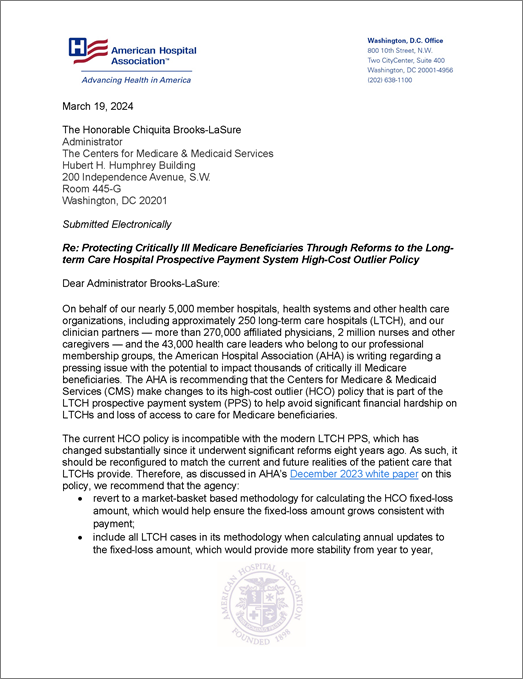Protecting Critically Ill Medicare Beneficiaries Through Reforms to the Long-term Care Hospital PPS High-Cost Outlier Policy
March 19, 2024
The Honorable Chiquita Brooks-LaSure
Administrator
The Centers for Medicare & Medicaid Services
Hubert H. Humphrey Building
200 Independence Avenue, S.W.
Room 445-G Washington, DC 20201
Submitted Electronically
Re: Protecting Critically Ill Medicare Beneficiaries Through Reforms to the Long-term Care Hospital Prospective Payment System High-Cost Outlier Policy
Dear Administrator Brooks-LaSure:
On behalf of our nearly 5,000 member hospitals, health systems and other health care organizations, including approximately 250 long-term care hospitals (LTCH), and our clinician partners — more than 270,000 affiliated physicians, 2 million nurses and other caregivers — and the 43,000 health care leaders who belong to our professional membership groups, the American Hospital Association (AHA) is writing regarding a pressing issue with the potential to impact thousands of critically ill Medicare beneficiaries. The AHA is recommending that the Centers for Medicare & Medicaid Services (CMS) make changes to its high-cost outlier (HCO) policy that is part of the LTCH prospective payment system (PPS) to help avoid significant financial hardship on LTCHs and loss of access to care for Medicare beneficiaries.
The current HCO policy is incompatible with the modern LTCH PPS, which has changed substantially since it underwent significant reforms eight years ago. As such, it should be reconfigured to match the current and future realities of the patient care that LTCHs provide. Therefore, as discussed in AHA’s December 2023 white paper on this policy, we recommend that the agency:
- revert to a market-basket based methodology for calculating the HCO fixed-loss amount, which would help ensure the fixed-loss amount grows consistent with payment;
- include all LTCH cases in its methodology when calculating annual updates to the fixed-loss amount, which would provide more stability from year to year, allowing providers to better predict both HCO losses and the partial relief provided by the HCO policy; and
- initiate an analysis of LTCH cases’ cost variation within payment groups to determine whether refinements to improve overall payment accuracy are needed.
BACKGROUND
As CMS is aware, LTCHs play highly specialized roles in the care continuum by focusing on caring for critically ill, medically complex patients that require extended hospital stays. Less than 1% of Medicare beneficiaries discharged from short-term acute-care hospitals (STACHs) are sent to an LTCH, but these are the most highly acute patients.
In recognition of the unique patients served by LTCHs, Congress in 1999 and 2000 directed CMS to establish the LTCH PPS. Then, in 2016, CMS implemented substantial reforms to the LTCH PPS. This included a dual-rate payment policy, which made full payment (the “standard rate”) only for beneficiaries who were admitted following STACH stays with at least three days in the ICU, or if the patient received ventilator services for at least 96 hours during their stay in the LTCH. If beneficiaries do not meet this criteria, LTCHs are paid a rate equivalent to what a STACH would be paid through the inpatient PPS (IPPS) (the “IPPS-equivalent rate”).
This policy has had far-reaching implications for the LTCH field. Most notably, the number of standard rate cases has fallen by more than 40%, from approximately 74,000 in 2016, to only 42,000 in 2022. In addition, the number of Medicare-participating LTCHs has also decreased by 20% in that same period. As explained more below, 2016 reforms and other market dynamics have yielded a significantly altered, more acute patient mix in LTCHs. However, the reforms left untouched certain components of the LTCH PPS, including its HCO policy. Under this policy, LTCHs must incur a set amount of loss before they are eligible for additional reimbursement (the “fixed-loss amount”). Prior to fiscal year (FY) 2018, CMS used its regulatory authority to set the fixed-loss amount for LTCH standard rate cases so that outlier payments would be equal to 8% of total payments. However, beginning in FY 2018, Congress required CMS to set the fixed-loss amount such that estimated outlier payments would equal only 7.975% of total LTCH payments. CMS sets the fixed-loss amount prospectively based on historical claims data to target paying out 7.975% of total payments as HCO payments.
In addition, since FY 2022, CMS has utilized a methodology that examines recent claims data to forecast growth in charges for the coming FY (known as the “charge-inflation factor”). Prior to that, CMS utilized a different methodology, which tied the charge-inflation factor to the market basket update for LTCHs. When CMS made the change, the field warned it would lead to volatility, and indeed, these concerns have borne out; there have since been sharp increases in the fixed-loss amount.
View the detailed letter below.


